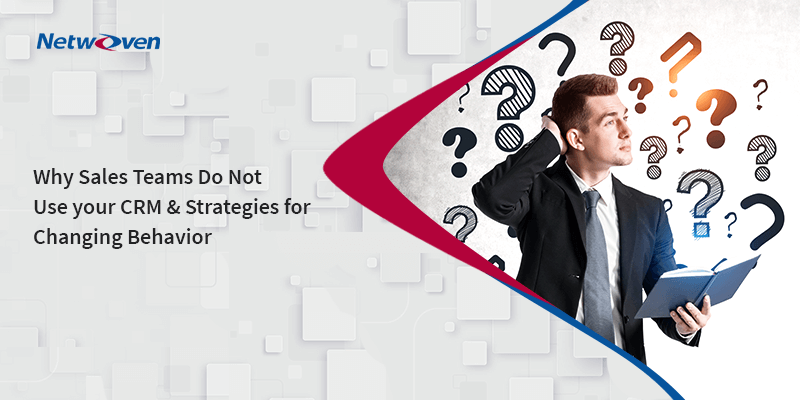Introduction:
Customer Relationship Management (CRM) is an organizational necessity for most modern enterprises. However, organizations are not getting the expected ROI from these critical tools due to a lack of higher user adoption. Sales teams are the hardest to onboard onto a CRM tool (as opposed to Customer Service reps).
Sales is human and we want Sales teams that are engaging, robust and people-oriented individual contributors. Without the proper consideration of their personas, you will end up alienating them. But to a sales team, CRM can seem dehumanized, cold, and possibly elicit job insecurities. Compare this to Customer Service, where answering the customer help chat is not a negotiable aspect of the role and supplying your call notes in a centralized tool is a requirement for employment. Sales teams have far more freedom and flexibility, which begs the question, ‘How can I get my Sales team to efficiently leverage CRM?’
In this article, Dynamics is the CRM of choice, but these tactics apply to any CRM application (Salesforce, NetSuite, etc.).
Why do Sales teams hesitate to leverage CRM?
1. “I don’t see any benefits”
This is the primary reason why Sales teams do not leverage an application. If there are no perceived benefits and users cannot answer the basic question of “What’s in it for me?,” then it is doomed to fail. As Change experts suggest, there are 3 things that are vital to combat this sentiment:
a. Establish management buy-in & sponsorship coalition
Ensure your middle management tier is fully bought-in on the Dynamics implementation. Start with the Senior Leadership and understand what aspects they want to tackle with a Dynamics implementation. Understand their desired outcomes and goals. Clarity, direction, and support from the Sponsorship group are critical.
b. Develop Change Champion Network
Work with Senior Leadership and middle management to identify core change champions. This group should be a mix of enthusiastic supporters and negative detractors. Leverage the energy from the supporters and help convert the resistors early.
c. Create a Communication Plan
Based on feedback ‘a’ and ‘b,’ you can generate an effective communication plan. Lean on the business outcomes and goals from management and leadership and the end-user perspective from supporters and resistors to build a communication plan that answers common questions and relieves anxiety.
An excellent communication plan to help build desire for a tool consists of:
- Various senders (communication needs to come from their group/their management team)
- Short & to the point
- More communication over less
2. “I don’t know how to use this thing”
The best applications are those that require little to no training.
Think about that… do you remember being taught how to use the Starbucks mobile app? How to do a Bing search? Did anyone sit with you while you made your first Amazon purchase?
Why are business applications different?
UX is not invested in Business Applications as much as it should be.
A wise friend of mine has an excellent rule of thumb for building amazing applications:
“Users will use a tool when they can access it where they are, they are able to kick off a process or take an action, and they learn something by using the app.”
– Greg Gant (who has worked for Starbucks amongst others)
Dynamics implementations need to-
- design the system to be where their user group is (if they are in the field, it better have field mobile capabilities and offline mode)
- be easy for the users to continue the process without leaving the application
- get better from using the tool (quick links to LinkedIn, presenting analytics data, providing directions, etc.)
Beyond design, a persona-based, scenario-driven training plan is critical. Here is an example:
| Topic | Presenter | Duration | Goals / Outcomes |
| Training Kickoff | Senior Leadership | 15 minutes | Attendees know why they are in the training and the importance of their active participation |
| Training Outcomes | Management | 15 minutes | Attendees understand their manager’s expectations for the training and high-level overview of what to expect |
| Scenarios | Management | 30 minutes | Review of scenarios to be covered during training. Validation that scenarios are well thought out and from their department |
| Dynamics walk through | Trainer | 30 minutes | High-level navigation of application, terminology review |
| Scenario 1 Breakout | Trainer & SME | 1 hour | Generate opportunities, provide call notes, and submit to Sales Operations |
3. “My leadership team doesn’t care”
Lastly, after the communication plans and go-live training, Dynamics will die on the vine if management does not continue to reinforce the change.
Common tactics:
- Dashboards – All Monday morning sales calls should be driven out of Dynamics.
- Data – Follow an ‘If it isn’t in Dynamics, then it doesn’t exist’ policy and stick to it. Reject help on a sales pursuit without data backing it in Dynamics.
- Gamification – Establish a leaderboard and measure what matters (e.g., converted leads in Dynamics as opposed to closed business. Closed business can technically happen outside of Dynamics, bypassing the point)
That makes sense, now how do I learn more?
The tools above lean on principles established by Prosci’s ADKAR (Awareness, Desire, Knowledge, Ability, and Reinforcement) Change Management methodology. All are critical for effective change management and ensuring high ROI for your dynamics roll-out. An extensive reading list is available online or through Prosci.
Reach out to us if you want to apply ADKAR to your Dynamics Sales implementation or implement Change Management Assessment or Sales Experience audit.






















